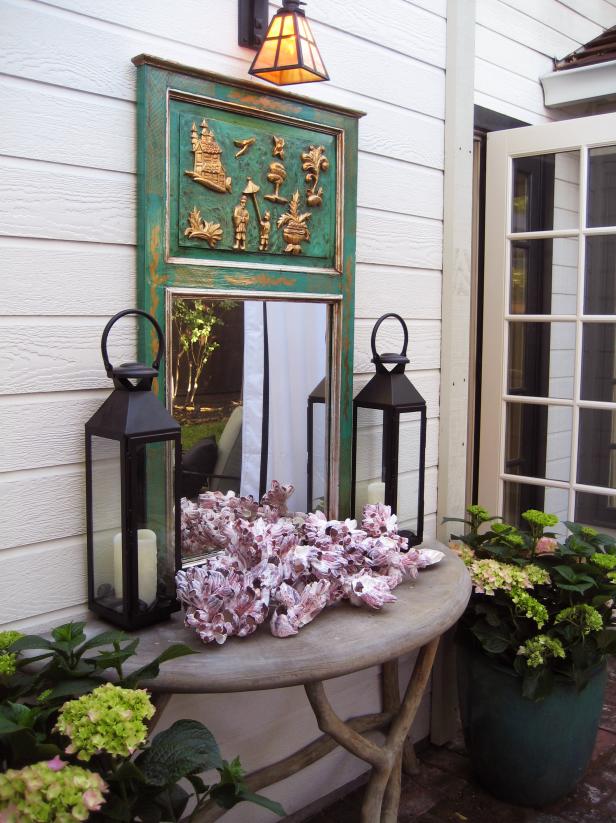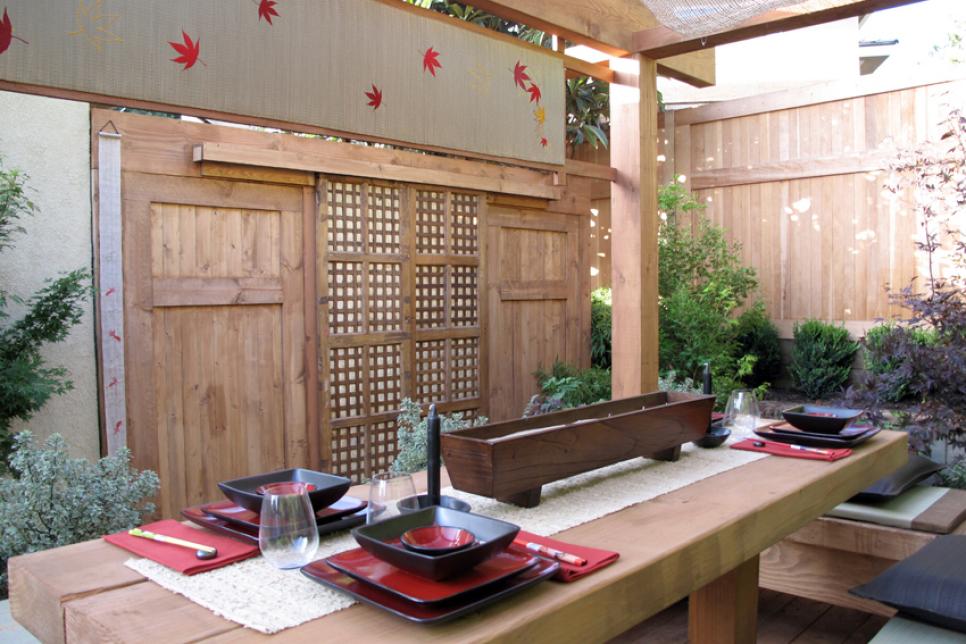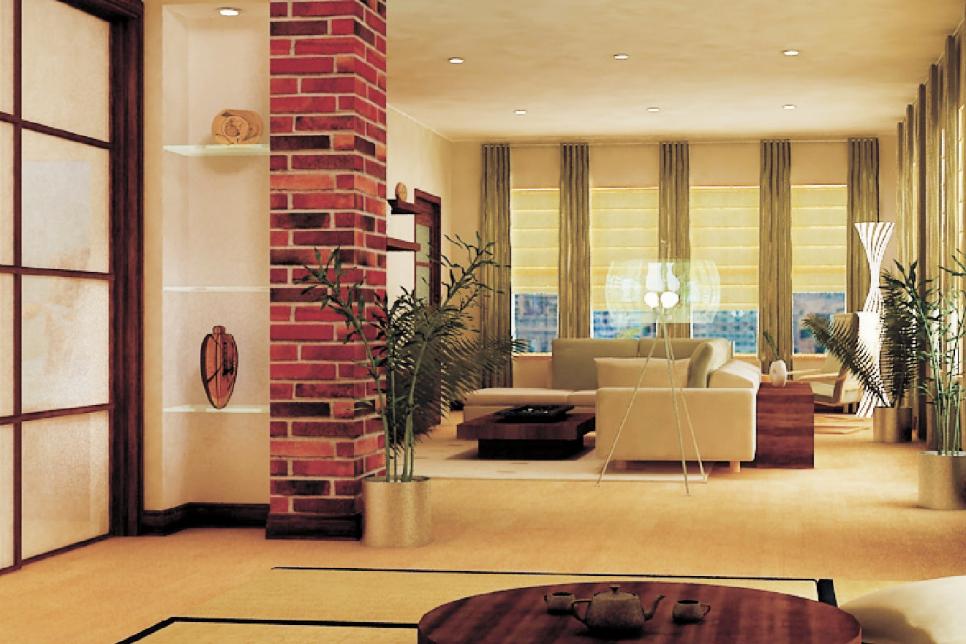
Cultural Flair Mix Asian and traditional elements into your design scheme for a tasteful yet diverse look. Within this informal living area designer Jane Ellison added a bold cobalt-blue color along the back wall to pull the muted blues in the couch detail, as well as the hues in the porcelain pieces. Oriental blue and white wares were created in China in the 14th century, and from the 17th century the bits were considered prized possessions and collected by European royalty. These porcelain pieces, together with the bamboo color, Japanese tatami mat and bronze accessories, pull in familiar Asian components while adding some unexpected cultural flair.

Zen State of Mind Zen is a Japanese school of Buddhism that aims to get a state of enlightenment through meditation and wisdom webpage. Many try to employ Zen principles in their lifestyle, in addition to within their design scheme, to produce a more soothing environment all around. In this elegant master bath, designer Gayle Wainwright of Chez Vous Interiors used calm, neutral colors, easy furnishings, natural substances and crisp, clean lines to create a balanced and harmonious area hop over to here. "Each detail has been selected carefully: the patina on the life-sized Buddha, in addition to the color and shape of the plants. All components add depth to the space," she says.

Modern Chinoiserie If chic, European decoration is more your style, add Asian flair using chinoiserie furniture, textiles and accessories. Chinoiserie (a French expression meaning "Chinese-esque") originated in 17th- and 18th-century Europe as a representation of literary influences through intricate and imaginary designs. With a touch of whimsy, the drawings and layouts are most often found on cabinets, porcelain objects and embroideries. HGTV fan LaDolfina mixed modern decor with chinoiserie influences for an elegant approach to Asian design his explanation company website. The most notable piece of chinoiserie decor is the fireplace and mantel, purchased in the Marais District in Paris.

Sweet Feng Shui The art of feng shui has been practiced in ancient Chinese civilizations for centuries but is currently being incorporated into Western interior design and structure visit the site. According to feng shui, everything has a positive or negative energy. To be able to balance these energies, designs must be carefully thought out to make an overall sense of stability in a room. Designer Marie Burgos integrated natural feng shui components into this Asian-style master bedroom, for example, color scheme, bamboo platform bed, hand-forged drum side tables and traditional Japanese shoji screens.

Tranquil Details To make a subtle Asian design, HGTV enthusiast Yorokobi incorporated relaxing colors of beige and weathered while combining contemporary and antique-inspired accessories Web Site original site. The most eye-catching part in the living room is that the stone art trio constituting distinct Chinese warriors, which immediately emits strength and power. Offset in the room, a stone statue of Kuan Yin, the bodhisattva of great compassion, functions as a serene and reassuring symbol of Buddhism, while adding a powerful, cultural element to the space.

Outdoor Elegance Revamp your deck or terrace by incorporating classic, Asian-inspired decoration into your design strategy his explanation. HGTV enthusiast LaDolfina taken the chinoiserie theme onto her outside pavilion with these thin, black sands and Kelly-green trumeau mirror basics have a peek at this website. Originally produced in 18th-century France, trumeau mirrors were meant to hang between windows to bring more light into the room and increase the decor. They are known for having an ornate and decorative part at the top, above the mirror, and are nearly always rectangular in shape. The gold illustrations with this version depict the European chinoiserie designs, while adding a decorative element to the home's exterior.

Japanese Serenity Nothing appears quite as relaxing as this exterior Asian-inspired garden, washitsu and dining room. A washitsu is a Japanese-style room famous for its tatami flooring and sliding doors go now. Typically measured by the size of the tatami mat, that this small washitsu is excellent for intimate gatherings and entertaining guests helpful site more info here. Designer Jamie Durie added a dry riverbed filled with crushed quartz to symbolize the lively flow of the room. A little dose of red divides the neutral colour scheme and natural green environment for an invigorating use of colour. It is possible to easily enhance the mood and vitality of your outside space by employing eco friendly materials and calm colors. Photography from Jason Busch

Antique Inspiration With background making a big comeback, HGTV enthusiast LaDolfina did not waste any time adding a gorgeous chinoiserie silk display mural into her powder room. Silk screening originated in Japan and has been known for its level of intricacy and also the abilities required to stencil print on cloth. The technique was finally carried to the West in the early 20th century and was regarded as a fine art form. Now, the wallpaper business makes it feasible to get the high quality appearance of silk screening on your home. To match the gold history of the mural, she included an antique, geometric mirror and cast-iron koi fish to the dressing table.

Passionate Hues In Western culture, red is a strong color that represents strong feelings, like enthusiasm, strength and passion. This deep colour also signifies the colour of the sun and is often associated with life, energy and vitality. Designer Jane Ellison maintained the colour scheme completely neutral in this Asian-style breakfast nook, permitting the red leather chair cushions to apply energy and create a bold statement on their own. To add an extra element of Japanese civilization, Jane incorporated new cherry blossoms into the design. Indigenous to East Asia, this plant is considered a sign for life and good fortune. The blossoms look particularly lovely in the Oriental blue and white porcelain vase.

Private Dining With pre-set table settings, a contemporary, Asian-style centerpiece and intimate surroundings, this Japanese-inspired outdoor area is ready for hosting dinner parties and hot weather get-togethers. A traditional Japanese table setting is made up of rice bowl, soup bowl, three flat side dishes, chopsticks and a chopsticks holder. Designer Jamie Durie depicts the classic Japanese dining table with Western flair by stacking the dishes to get a more space-saving and modern look. Japanese displays and an adjacent tatami space add to the solitude and feng shui of the space.

Conventional Style Most contemporary Japanese houses still consist of a minumum of one tatami room, much like the one in this California home. The minimalist allure of Japanese design is clearly seen through the ease of this room. Custom shoji screens allow the space to stay open to the other chambers of the house, with the ability to slide them shut for privacy. This short-legged dining table, or chabudai, is most common in traditional Japanese homes, originating from its small, box-shaped predecessors known as hazoken. The bigger table permits for more guests, along with the legs fold up for quick storage, allowing the room to provide greater usage than just dining. Design by HGTV fan RemodelWest

Modern Edge Asian-inspired design does not need to be filled with historical Japanese artifacts or chinoiserie decoration. This modern Asian bathroom incorporates the style's natural components, like bamboo and orchids, using contemporary materials and colors. The stainless steel construction on the ceiling reflects a Japanese bamboo and reed shade trellis but with modern appeal. Though surrounded by charcoal tile and stainless steel, the bathroom still elicits a feeling of tranquility for a spa-like experience. Design by Danenberg Design

Energetic Flow Designer Marie Burgos visually integrated the Chinese practice of Zen within this living room and yoga space. "Openness and light are the basis of this Zen design, that has been created to enhance the auspicious flow of endurance, energy and comfort," she states. Natural, eco-friendly components, including the bamboo wooden table, traditional Japanese tatami mats and Asian artwork, help create balance and stability in the space. By carefully choosing accessories and furniture, you are able to bring a natural, feng shui feel to your property.

Simplistic Design This Western representation of Asian influence pulls in the neutral tones often seen in the design, in addition to a minimalist usage of decor and accessories. Straight-lined, dark wood furniture follows the contemporary style often associated with Asian layout, whereas the bamboo walls and lampshade provide natural, eco-friendly elements within the area. A statue of Kuan Yin, the bodhisattva of compassion, adds an ancient Buddhist feel often desired for a Zen-like environment. Image courtesy of aspenhome

No comments:
Post a Comment